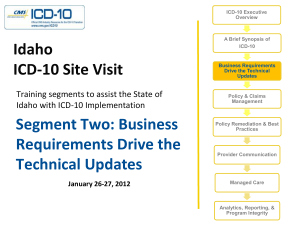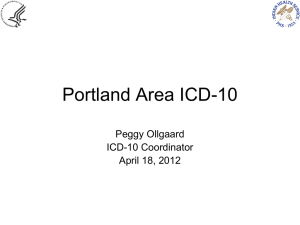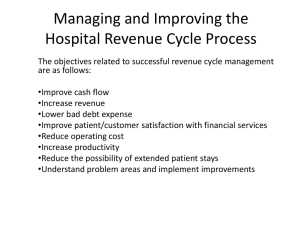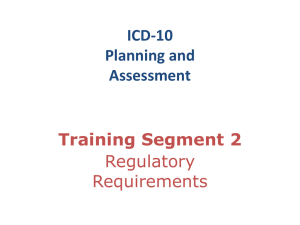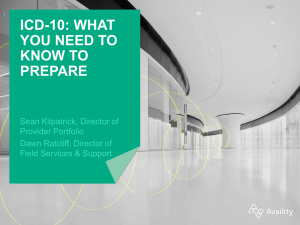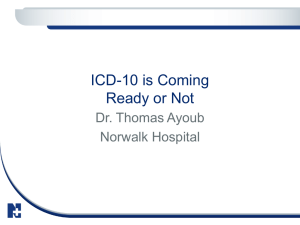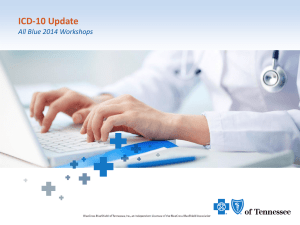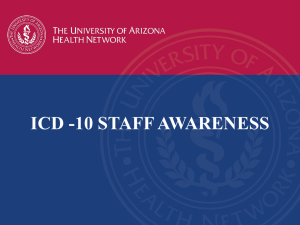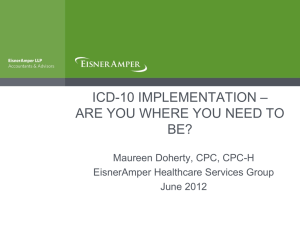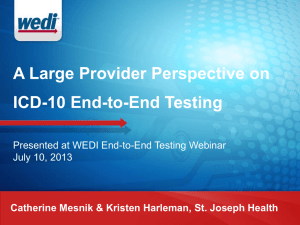Preparing for ICD-10 Implementation
advertisement
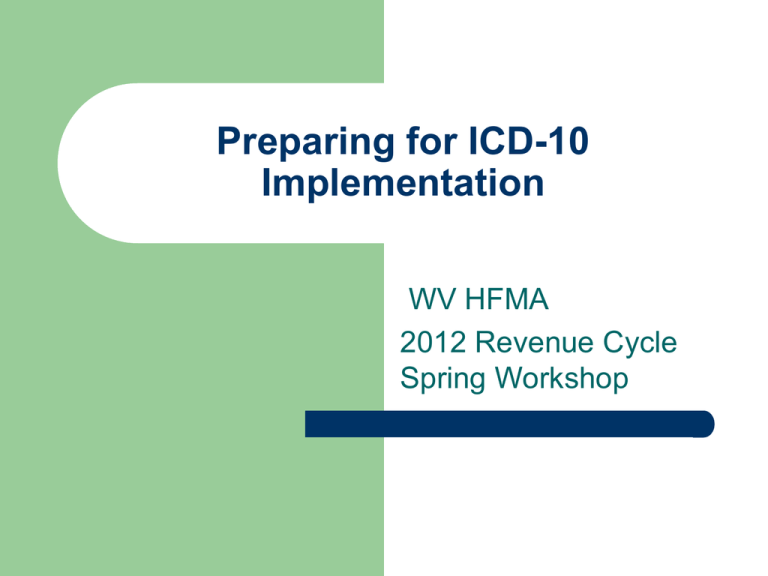
Preparing for ICD-10 Implementation WV HFMA 2012 Revenue Cycle Spring Workshop Vivian Shomo, CPC-I,CCS-P,CPAT Reimbursement Analyst II Davis Health System RECENT NEWS February 17, 2012 HHS announced it would initiate a process to postpone the date by which certain healthcare entities have to comply with ICD-10. Still waiting for details. 5010 deadline has been moved forward three more months to June 30, 2012 WHY WOULD WE CONTINUE TO PREPARE FOR ICD-10? ICD-10 IMPLEMENTATION Not limited to a coding mandate. Leaders in healthcare are aligning ICD-10 efforts with quality of care initiatives, quality reporting and accuracy of reimbursement. ICD-10 IMPLEMENTATION ICD-10-CM (diagnoses) will be used by all providers in every health care setting. ICD-10-PCS (procedures) will be used only for hospital claims for inpatient hospital procedures. ICD-10-PCS will not be used on physician claims, even those for inpatient visits. CPT & HCPCS No impact on CPT and HCPCS codes. CPT and HCPCS will continue to be used for physician and ambulatory services including outpatient hospital services and physician visits to inpatients. ICD-10 Implementation When a new implementation date is set Ambulatory and physician services provided on or after that date will use ICD-10-CM diagnosis codes. Inpatient discharges occurring on or after that date will use ICD-10-CM and ICD-10PCS codes. ICD-10 Implementation Challenges Initially it will impact coder productivity. Two coding systems will be used for claims before and after the implementation date. Vendor and payer readiness. Worker’s Compensation and Auto Insurances are not included in the mandate. ICD-10 DIFFERENCES ICD-10 codes are different from ICD-9 codes - they provide greater detail in describing diagnosis and procedures. - there are more ICD-10 codes than ICD-9. ICD-10 codes are longer and use more alpha characters. System changes are required to accommodate ICD-10 codes. Ex. Acute Serous Otitis Media ICD-9-CM 381.01 Acute Serous Otitis Media ICD-10-CM H65.00 Acute SOM,Unsp Ear H65.01Acute SOM,R Ear H65.02 Acute SOM,L Ear H65.03 Acute SOM, Bilat H65.04 Acute SOM,Recurr R Ear H65.05 Acute SOM,Recurr L Ear H65.06 Acute SOM, Recurr Bilat H65.07 Acute SOM, Recurr,Unspec Ear UNSPECIFIED CODES IN ICD-10 ICD-10 does include unspecified codes. Payers will continue to make independent judgments about how unspecified codes should be handled under a payment or coverage policy. What should we be doing now? Preparing for Implementation AWARENESS EDUCATION Educate medical staff on: - Impact on documentation Coders and other HIM professionals should: - Become familiar with the structure, organization, and unique features of ICD-10. IMPACT ASSESSMENT Assess organizational readiness - identify affected business areas and individuals - indentify affected systems, applications, databases - assess impact on documentation processes and work flow IMPACT ASSESSMENT (cont) Identify reports and forms requiring modification. Identify policies/procedures that need to be developed or revised Assess business associate readiness (e.g., systems vendors, payers) IMPACT ASSESSMENT (cont.) Identify impacted internal and external reporting processes (e.g., registries, quality measures, performance measures, state data reporting) Assess impact on coding and billing productivity DETERMINE VENDOR READINESS Ask your systems vendors: - What systems upgrades or replacements are needed to accommodate ICD-10? - What costs are involved and will upgrades be covered by existing contracts? - When will upgrades or replacement systems be available for testing? DETERMINE VENDOR READINESS (cont.) - What customer support and training will they provide? - How will their products/services accommodate both ICD-9 and ICD-10 as you work with claims submitted both before and after the implementation date? Systems/Applications Potentially Affected by Transition (not all-inclusive list) Encoding software Medical record abstracting systems Billing systems Practice management systems Groupers Electronic health record systems Clinical systems Decision support systems Registration and scheduling Utilization management Quality management Case mix systems Case management Disease management Financial Medical necessity software Registries Compliance software Patient assessment data sets ASSESS SYSTEMS IMPACT Determine how long both ICD-9 and ICD-10 code sets will need to be supported. Will system storage capacity need to be increased? Identify new or upgraded hardware/software requirements. Build flexibility into IT systems currently under development. ASSESS CODING PROFESSIONALS’ ADDITIONAL TRAINING NEEDS Anatomy and physiology, medical terminology and pharmacology. Coder retention. Intensive coder training in the code sets should not be provided until 6-9 months prior to implementation. 2 full days of ICD-10 code set training will likely be adequate for most coders, and very proficient ICD-9 coders may not need that much. ASSESS QUALITY OF MEDICAL RECORD DOCUMENTATION Evaluate samples of various types of medical records to determine whether documentation supports level of detail found in ICD-10 Implement documentation improvement strategies where needed Nonspecific codes are still available in ICD-10 CMS ICD-10 Website The CMS ICD-10 website http://www.cms.gov/icd10 provides the latest ICD-10 information and links to resources for providers to prepare for ICD-10 implementation in a 5010 environment. CMS Sponsored ICD-10 Teleconferences http://www.cms.gov/ICD10/Tel10/list.asp Provides information on upcoming and previous CMS national provider ICD-10 teleconferences, including registration, presentation materials, written transcripts and audio recordings. AHIMA RESOURCES http://www.ahima.org/icd10 Practical Guidance (free) - preparation checklists and tools - superbill examples Books Online Courses Academy for ICD-10 Trainers E-newsletter (free) Articles (many are free) Webinars/Conferences QUESTIONS?

